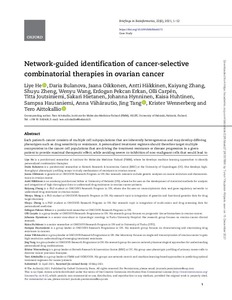Network-guided identification of cancer-selective combinatorial therapies in ovarian cancer
He Liye; Bulanova Daria; Oikkonen Jaana; Häkkinen Antti; Zhang Kaiyang; Zheng Shuyu; Wang Wenyu; Erkan Erdogan Pekcan; Carpén Olli; Joutsiniemi Titta; Hietanen Sakari; Hynninen Johanna; Huhtinen Kaisa; Hautaniemi Sampsa; Vähärautio Anna; Tang Jing; Wennerberg Krister; Aittokallio Tero
https://urn.fi/URN:NBN:fi-fe2022012710995
Tiivistelmä
Each patient's cancer consists of multiple cell subpopulations that are inherently heterogeneous and may develop differing phenotypes such as drug sensitivity or resistance. A personalized treatment regimen should therefore target multiple oncoproteins in the cancer cell populations that are driving the treatment resistance or disease progression in a given patient to provide maximal therapeutic effect, while avoiding severe co-inhibition of non-malignant cells that would lead to toxic side effects. To address the intra- and inter-tumoral heterogeneity when designing combinatorial treatment regimens for cancer patients, we have implemented a machine learning-based platform to guide identification of safe and effective combinatorial treatments that selectively inhibit cancer-related dysfunctions or resistance mechanisms in individual patients. In this case study, we show how the platform enables prediction of cancer-selective drug combinations for patients with high-grade serous ovarian cancer using single-cell imaging cytometry drug response assay, combined with genome-wide transcriptomic and genetic profiles. The platform makes use of drug-target interaction networks to prioritize those combinations that warrant further preclinical testing in scarce patient-derived primary cells. During the case study in ovarian cancer patients, we investigated (i) the relative performance of various ensemble learning algorithms for drug response prediction, (ii) the use of matched single-cell RNA-sequencing data to deconvolute cell population-specific transcriptome profiles from bulk RNA-seq data, (iii) and whether multi-patient or patient-specific predictive models lead to better predictive accuracy. The general platform and the comparison results are expected to become useful for future studies that use similar predictive approaches also in other cancer types.
Kokoelmat
- Rinnakkaistallenteet [27094]
